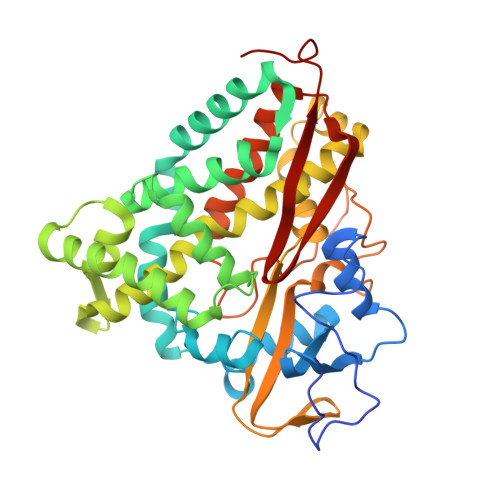Crystal structures of metyrapone- and phenylimidazole-inhibited complexes of cytochrome P-450cam.
Poulos, T.L., Howard, A.J.(1987) Biochemistry 26: 8165-8174
- PubMed: 3442650
- DOI: https://doi.org/10.1021/bi00399a022
- Primary Citation of Related Structures:
1PHD, 1PHE, 1PHF, 1PHG - PubMed Abstract:
The crystal structures of metyrapone- and 1-, 2-, and 4-phenylimidazole-inhibited complexes of cytochrome P-450cam have been refined to a nominal resolution of 2.1 A and compared with the 1.63-A camphor-bound structure. With the exception of 2-phenylimidazole, each of the inhibitors forms an N-Fe bond with the heme iron atom while part of the inhibitor sits in the camphor-binding pocket. In the 2-phenylimidazole complex, a water molecule or hydroxide ion coordinates with the heme iron atom while the inhibitor binds in the camphor pocket adjacent to the aqua ligand. Each of the inhibitors forces the central region of helix I that forms part of the O2 binding pocket to move away from the inhibitor, with the exception of 2-phenylimidazole where the helix moves in toward the inhibitor. In addition, the Tyr-96 region, which provides specific contact points with the substrate, is perturbed, although to varying degrees with each inhibitor. These perturbations include large, localized changes in Debye-Waller or temperature factors, indicative of changes in dynamical fluctuations. The largest inhibitor, metyrapone, causes the fewest changes, while 2-phenylimidazole binding causes the largest, especially in helix I. The large 2-phenylimidazole-induced movement of helix I can be rationalized on the basis of the inhibitor imidazole group's hydrogen-bonding requirements.
- Protein Engineering Department, Genex Corporation, Gaithersburg, Maryland 20877.
Organizational Affiliation:


















